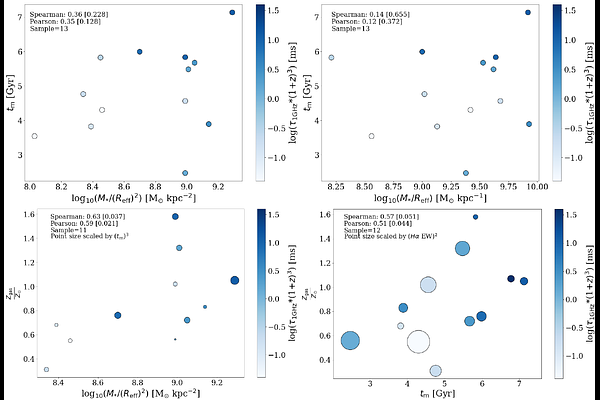An investigation into correlations between FRB and host galaxy properties

An investigation into correlations between FRB and host galaxy properties
M. Glowacki, A. Bera, C. W. James, J. Paterson, A. T. Deller, A C. Gordon, L. Marnoch, A. R. Muller, J. X. Prochaska, S. D. Ryder, R. M. Shannon, N. Tejos, A. G. Mannings
AbstractImpulsive radio signals such as fast radio bursts (FRBs) are imprinted with the signatures of multi-path propagation through ionised media in the form of frequency-dependent temporal broadening of the pulse profile (scattering). The dominant source of scattering for most FRBs is expected to be within their host galaxies, an assumption which can be tested by examining potential correlations between properties of the FRBs and global properties of their hosts. Using results from the CRAFT survey, we investigate correlations across a range of host galaxy properties against attributes of the FRB that encode propagation effects: scattering timescale tau, polarisation fractions, and absolute Faraday rotation measure. From 21 host galaxy properties considered, we find three correlated with tau, including the stellar surface density (or compactness; Pearson p-value p = 0.002 and Spearman p = 0.010), mass-weighted age (Spearman p-value p = 0.009), and a weaker correlation with gas-phase metallicity (Spearman p = 0.017). Weakly significant correlations are also found with Halpha equivalent widths and gravitational potential. From 10,000 trials of reshuffled datasets, we expect 2 strong Spearman correlations only 2% of the time, and three weaker correlations in 6.6% of cases. Compact host galaxies may have more ionised content which scatters the FRB further. No correlation is seen with host galaxy inclination, which weakens the case for an inclination bias, as previously suggested for samples of localised FRBs. A strong (p = 0.002) correlation is found for absolute rotation measure with optical disc axis ratio b/a; greater rotation measures are seen for edge-on host galaxies. Further high-time resolution FRB detections, coupled with localisation and detailed follow-up on their host galaxies, are necessary to corroborate these initial findings and shed further light into the FRB mechanism.